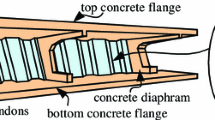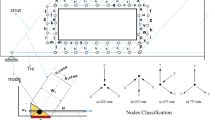Abstract
Presented are the results from a finite element model of steel–concrete composite beams with deep decks and a comparison with various analytical/design methods. Using a deck deeper than 80 mm are becoming popular with a desire for longer spanning capability and lower concrete volume. However, there are no design rules in either American or European design codes for using a deck deeper than 80 mm, as both codes limit the deck rib height to 75 and 85 mm, respectively for using the stud’s capacity formula. Therefore, research is needed to establish the design stud capacity in beams with decks deeper than 80 mm. After extensive validation, the 3-D FE model is used for a parametric study with tests having decks deeper than 80 mm. The parameters include rib geometries, studs’ layout and concrete slab reinforcements. The FE results showed that stud capacity with narrow and deep decks (100–150 mm) is about 70% of the conventional decking (60–80 mm deep). The stud capacities from the numerical results were compared to the predicted strengths from the design/theoretical models. While the equations from the concrete pull-out failure mode by Johnson and Yuan (Proc Inst Civ Eng Struct Build 128(3):252–263, 1998) gave reasonable predictions with a coefficient of variation as 11%, both EC4 and ANSI/AISC rules provided inaccurate and inconsistent predicted strengths. A generalised stud capacity formula should be developed in the design codes for decks deeper than 80 mm.






























Similar content being viewed by others
Abbreviations
- A s :
-
Cross-sectional area of shear connector stud
- A Wulst,eff :
-
Effective area of weld collar
- b o :
-
Average rib width of profiled steel deck
- C:
-
Central position of stud
- c1, c2 :
-
Material constants equal to 3.0 and 6.93, respectively
- d :
-
Diameter of shear connector stud
- d c :
-
Compressive damage variable
- d t :
-
Tensile damage variable
- d Wulst :
-
Diameter of weld collar
- e :
-
Distance from centre of stud to nearer wall of rib
- E c :
-
Young’s modulus of concrete
- E cm :
-
Secant modulus of elasticity of concrete
- E s :
-
Young’s modulus of steel
- F:
-
Favourable position of stud
- f c :
-
Compressive cylinder strength of concrete
- f cm :
-
Mean value of concrete cylinder compressive strength
- f cu :
-
Compressive cube strength of concrete
- f t :
-
Tensile strength of concrete
- f u :
-
Minimum ultimate tensile strength of shear connector stud
- f uk :
-
Characteristic tensile strength of shear connector stud
- f y :
-
Yield stress of steel
- f yp :
-
Yield strength of sheeting
- G f :
-
Fracture energy of concrete
- G fo :
-
Initial fracture energy of concrete
- h p :
-
Rib height of profiled steel deck
- HPS:
-
High Performance Steel
- h sc :
-
Total height of shear stud connector
- h Wulst :
-
Height of weld collar
- kcpt, kcpt, ηcpt, ηcpt :
-
Non-dimensional group for concrete pull-out failure mode
- krp, kcp, ηrp, ηcp :
-
Non-dimensional group for punching and concrete pull-out failure mode
- k t :
-
Reduction factor
- N r :
-
Number of studs per rib
- P AISC :
-
Nominal unfactored design strength calculated from American code
- P CPT :
-
Shear connector resistance per stud obtained from concrete pull-out failure mode
- P EC4 :
-
Nominal unfactored design strength calculated from European code
- PFE :
-
Shear connector resistance per stud obtained from the finite element analysis
- P m,c :
-
Shear connector resistance per stud obtained from concrete failure
- P m,s :
-
Shear connector resistance per stud obtained from stud failure
- P Rm :
-
Mean shear resistance of stud
- P RPCP :
-
Shear connector resistance per stud obtained from rib punching and concrete pull-out failure mode
- PTest :
-
Shear connector resistance per stud obtained from experiments
- Rg, Rp :
-
Reduction factors specified in the American Code
- s t :
-
Transverse centre to centre spacing between studs
- t s :
-
Thickness of profiled steel decking
- T y :
-
Resistance of shear stud to uniaxial tension
- U:
-
Unfavourable position of stud
- v tu :
-
Shear strength of concrete
- w :
-
Crack opening displacement
- w c :
-
Ultimate crack opening displacement
- w o :
-
Density of concrete
- ε c ~in :
-
Compressive inelastic strain of concrete
- ε c ~ pl :
-
Compressive plastic strain of concrete
- ε y :
-
Plastic strain of steel
- σ c :
-
Compressive stress of concrete
- σ c0 :
-
Initial yield stress of concrete
- σ cu :
-
Ultimate compressive stress of concrete
- σ t :
-
Tensile stress of concrete
References
ABAQUS Documentations. (2014). ABAQUS user’s manual. Version 6.14, Hibbitt, Karlsson and Sorenson, USA
Adany, S., Kachichian, M., Kovesdi, B., & Dunai, L. (2013). Experimental studies on deep trapezoidal sheeting with perforated webs. Journal of Structural Engineering, ASCE,139(5), 729–739.
ANSI, AISC 360. (2016). Specification for structural steel buildings. Chicago, IL: American Institute of Steel Construction.
ASC Steel Deck. (2016). Floor deck catalogue. Sacramento, CA: Manufactures of ASC Steel Deck profiles.
BS En 1992-1-1. (2004). Eurocode 2: Design of concrete structures: Part 1–1: General rules and rules for buildings. London: British Standard Institution.
BS EN 1994-1-1. (2004). Eurocode 4: Design of composite steel and concrete structures: Part 1.1: General rules and rules for buildings. London: British Standard Institution.
CEB-FIP Model Code. (2010). The International Federation for Structural Concrete, Switzerland.
Chen, L. Z., Ranzi, G., Jiang, S. C., Tahmasebinia, F., & Li, G. Q. (2015). Behaviour and design of shear connectors in composite slabs at elevated temperatures. Journal of Constructional Steel Research,115, 387–397.
Cornelissen, H. A. W., Hordijk, D. A., & Reinhardt, H. W. (1986). Experimental determination of crack softening characteristics of normalweight and lightweight-concrete. Heron,31(2), 45–56.
Ernest, S., Bridge, R., & Wheeler, A. (2010). Correlation of beam tests with pushout tests in steel–concrete composite beams. Journal of Structural Engineering, ASCE,136(2), 183–192.
Johnson, R. P., & Yuan, H. (1998). Models and design rules for stud shear connectors in troughs of profiled sheeting. Proceeding of the Institution of Civil Engineers, Structures and Buildings,128(3), 252–263.
Katwal, U., Tao, Z., & Hassan, M. K. (2018). Finite element modelling of steel–concrete composite beams with profiled steel sheeting. Journal of Constructional Steel Research,146, 1–15.
Kingspan Multideck Technical Handbook. (2011). Manufactures of multideck composite metal decking. North Yorkshire, United Kingdom.
Konrad, M. (2011). Structural behaviour of headed studs with trapezoidal profiled sheeting. Ph.D. Thesis, University of Stuttgart, Germany (in German).
Lawson, R.M. (1997). Shear connection in composite beams-influence of steel deck shape. In Proceeding of the Engineering Foundation Conference, Composite Construction in Steel and Concrete III, ASCE, Irsee, Germany, pp. 312–324.
Lloyd, R. M., & Wright, H. D. (1990). Shear connection between composite slabs and steel beams. Journal of Constructional Steel Research,15(4), 255–285.
Naghavi, M., Rahnavard, R., Thomas, R. J., & Malekinejad, M. (2019). Numerical evaluation of the hysteretic behavior of concentrically braced frames and buckling restrained brace frame systems. Journal of Building Engineering,22, 415–428.
Nellinger, S., Eggert, F., Kuhlmann, U., Odenbreit, C., & Obiala, R. (2018). Short-span composite beam tests to evaluate stud resistances. Proceeding of the Institution of Civil Engineers, Structures and Building,171(1), 17–28.
Nellinger, S., Odenbreit, C., Obiala, R., & Lawson, M. (2017). Influence of transverse loading onto push-out tests with deep steel decking. Journal of Constructional Steel Research,128(1), 335–353.
Qureshi, J. (2010). Finite element modelling of steel–concrete composite structures. Ph.D. Thesis, University of Leeds, Leeds, United Kingdom.
Qureshi, J., Lam, D., & Ye, J. (2011a). Effect of shear connector spacing and layout on the shear connector capacity in composite beams. Journal of Constructional Steel Research,67(4), 706–719.
Qureshi, J., Lam, D., & Ye, J. (2011b). The influence of profiled sheeting thickness and shear connector's position on strength and ductility of headed shear connector. Engineering Structures,33(5), 1643–1656.
Rahnavard, R., & Hassanipour, A. (2015). Steel Structures analysis using ABAQUS. Kerman: Academic Center for Education, Culture and Research, Publishing Organization of Kerman Branch.
Rahnavard, R., Hassanipour, A., & Mounesi, A. (2016). Numerical study on important parameters of composite steel–concrete shear walls. Journal of Constructional Steel Research,121, 441–456.
Rahnavard, R., Hassanipour, A., Suleiman, M., & Mokhtari, A. (2017a). Evaluation on eccentrically braced frame with single and double shear panel. Journal of Building Engineering,10, 13–25.
Rahnavard, R., Khaje, M. T., Hassanipour, A., & Siahpolo, N. (2017b). Parametric study of seismic performance of steel bridges pier rehabilitated with composite connection. Journal of Structural and Construction Engineering. https://doi.org/10.22065/JSCE.2017.92128.1259.
Rahnavard, R., Naghavi, M., Aboudi, M., & Suleiman, M. (2018). Investigating modeling approaches of buckling-restrained braces under cyclic loads. Case Studies in Construction Materials,8, 476–488.
Rambo-Roddenberry, M. D. (2002). Behaviour and strength of welded stud shear connectors. Ph.D. Thesis, Virginia Polytechnic Institute and State University.
Robinson, R. (1988). Multiple stud shear connections in deep ribbed metal deck. Canadian Journal of Civil Engineering,15(4), 553–569.
Shin, D. K., Dat, B. V., & Kim, K. (2014). Compressive strength of HPS box girder flanges stiffened with open ribs. Journal of Constructional Steel Research,95, 230–241.
Shin, D. K., Le, V. A., & Kim, K. (2013). In-plane ultimate compressive strengths of HPS deck panel with U-shaped ribs. Thin-Walled Structures,63, 70–81.
Smith, A. L., & Couchman, G. H. (2010). Strength and ductility of headed stud shear connectors in profiled sheeting. Journal of Constructional Steel Research,66(6), 748–754.
Suresh, K., & Regalla, S. P. (2014). Effect of time scaling and mass scaling in numerical simulation of incremental forming. Applied Mechanics and Materials,612, 105–110.
Tata Steel. (2016). Composite floor decking design and technical information. United Kingdom.
Acknowledgements
The authors would like to acknowledge the University of East London for their facilities. Also, the first author is sincerely grateful to the Higher Committee for Education Development in Iraq for his PhD study.
Author information
Authors and Affiliations
Corresponding author
Additional information
Publisher's Note
Springer Nature remains neutral with regard to jurisdictional claims in published maps and institutional affiliations.
Rights and permissions
About this article
Cite this article
Albarram, A., Qureshi, J. & Abbas, A. Effect of Rib Geometry in Steel–Concrete Composite Beams with Deep Profiled Sheeting. Int J Steel Struct 20, 931–953 (2020). https://doi.org/10.1007/s13296-020-00333-5
Received:
Accepted:
Published:
Issue Date:
DOI: https://doi.org/10.1007/s13296-020-00333-5




